
USS Sea Hawk (SP-2365) was an armed motorboat that served in the United States Navy as a patrol vessel from 1917 to 1919.
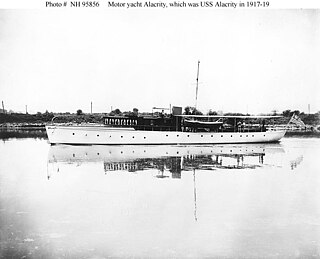
USS Alacrity (SP-206) was a steel cruising yacht that served in the US Navy as a section patrol craft. It was built by Pusey & Jones at Wilmington, Delaware for W. A. Bradford in 1910 then sold to John H. Blodgett of Boston.
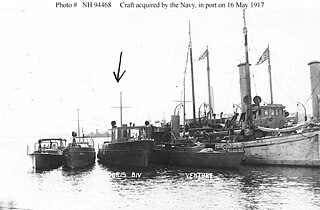
Gypsy (SP-55) was the planned designation for a motorboat the United States Navy acquired in 1917 for use as a patrol vessel but which was destroyed by a fire before she could be commissioned.

USS Lynx II (SP-730), later USS SP-730, was an armed motorboat that served in the United States Navy as a patrol vessel and harbor dispatch boat from 1917 to 1919.

USS Patrol No. 1 (SP-45), often rendered as USS Patrol #1, was an armed motorboat that served in the United States Navy as a patrol vessel from 1917 to 1919.

The first USS Manatee (SP-51) was an armed motorboat that served as a United States Navy patrol vessel from 1917 until sometime shortly after World War I.

USS Liberty III (SP-1229), sometimes written Liberty # 3, and also referred to during her naval career as Liberty and as Pilot Boat Liberty, No. 3, was a United States Navy patrol vessel in commission from 1917 to 1919. The Liberty was a pilot boat from 1896-1917. She was a replacement for the pilot boat D. J. Lawlor. After World War I, the Liberty returned to pilot service until 1934 when she was purchased as a yacht.

The Columbia was a 19th-century pilot boat built C. & R. Poillon shipyard in 1879 for Sandy Hook and New York pilots that owned the Isaac Webb, which was lost off Quonochontaug Beach, Long Island in July 1879. She was run down by the Guion Line steamer SS Alaska in 1883. A second pilot-boat, also named Columbia, was built by Ambrose A. Martin at East Boston in 1894 that had a unique spoon bow and was extremely fast. She was thrown ashore in the great Portland Gale, and remained on the Sand Hills beach in Scituate, Massachusetts for over thirty years as a marine curiosity. The Louise No. 2 replaced the ill-fated Columbia.

The Richard K. Fox, first named Lillie, was a 19th-century pilot boat built in 1876 for Boston Pilots. She was designed by model by Dennison J. Lawlor. She was one of the most graceful and attractive of the Boston pilot-boats and represented a trend toward deep-bodied boats. She was later sold to the New York pilots and renamed Richard K. Fox in honor of the famous sportsman and publisher of the Police Gazette. In the age of steam, she was sold in 1896 to the Marine Hospital Service.
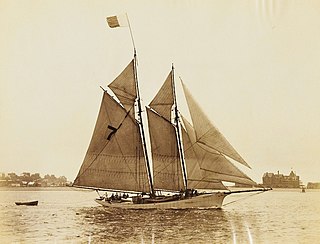
Minerva was a 19th-century Boston pilot boat built in 1896 by Ambrose A. Martin of East Boston, Massachusetts. She was owned by Franklin B. Wellock who was a Boston pilot for more than 55 years. The pilot-boat was named for his daughter, Minerva Hill. She was sold to Plymouth parties in 1901 to be used as a fishing vessel.
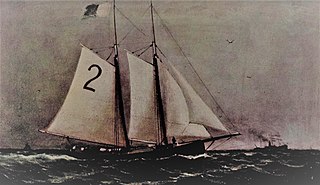
The Eben D. Jordan was a 19th-century Boston pilot boat built in 1883 by Ambrose A. Martin in East Boston for Captain Thomas Cooper. Her namesake was Eben Dyer Jordan, the founder of the Jordan Marsh department stores. In 1892, she was sold to the New York Sandy Hook pilots. She was one of the last of the pilot-boats that were discarded in an age of steam and electricity in 1896.

The Adams was a 19th-century Boston pilot boat, built in 1888 by Moses Adams at Essex, Massachusetts for Captain John H. Jeffries. She was named for Melvin O. Adams, an American attorney and railroad executive. Her design was by yacht designer Edward Burgess, known for his America's Cup defenders. In 1901, she was one of only five pilot-boats left in the Boston fleet. In 1912, she was sold to haul gravel to Boston, then sold again where she landed in the Portuguese immigrant trade. She was sunk by enemy action during World War I.

The Varuna was a 19th-century Boston pilot boat, built by Montgomery & Howard at Chelsea, Massachusetts in 1890, for a group of Boston pilots. She was designed by yacht designer Edward Burgess, known for his America's Cup defenders. She was the first centerboard pilot-boat in operation in the Massachusetts Bay. The Varuna went out of service in 1912 because of the introduction of steam power into pilot-boats. She was later sold to Stephen Simmons to be used as a trading vessel between ports in the Spanish Main in 1913.

The Edward E. Barrett, or Edward E. Bartlett, was a 19th-century two-masted Sandy Hook pilot boat, built by C. & R. Poillon in 1883 and designed by William Townsend. She helped transport New Jersey maritime pilots between inbound or outbound ships coming into the New York Harbor. She was one of the pilot boats that survived the Great Blizzard of 1888. In the age of steam, the Barrett ended her pilot commission and was sold in 1904.
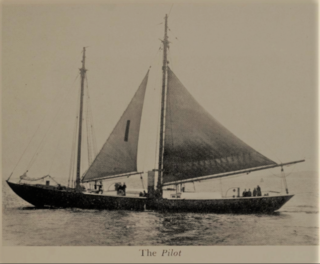
The Pilot was a pilot boat built in 1924 and designed by yacht designer William Starling Burgess. She was purchased by the Boston Pilots' Association to take the place of the pilot boat Louise that was withdrawn from service in 1924. The Pilot was in service for over fifty years before she was sold in 1976. She became the longest-serving pilot boat in American history.

The Friend was a 19th-century pilot boat built by Daniel D. Kelley & Holmes East Boston shipyard in 1848 for Boston pilots. She helped transport Boston maritime pilots between inbound or outbound ships coming into the Boston Harbor. The Friend was one of the last of the low sided, straight sheared schooners built in the 1840s for Boston pilots. The second Boston pilot boat Friend was built in 1887. Her name came from the older Friend that was in the service in the late 1840s. Captain Thomas Cooper sold the Friend to New York pilots in 1893. Cooper replaced the Friend with the pilot-boat Columbia in 1894.

Captain Bruce Boutlier McLean was a 19th-century Boston maritime pilot, best known for being a pilot on the pilot boat America. He was a leader among the branch pilots of Boston for 35 years. McLean was a pilot and owner of the pilot boat Liberty. He died in Everett, Massachusetts, in 1930.

John Crossland Fawcett was a 19th-century American Boston harbor pilot. He is best known for being a member of the Boston Pilots' Association for 19 years. He was an owner and pilot on the pilot boats Columbia and Louise. He died by suicide in his cabin on the pilot boat Louise in 1908 off Half Way Rock.
Ambrose A. Martin, was a 19th-century Boston, Massachusetts yacht and boat shipbuilder. He built the Ambrose A. Martin shipyard in 1882 at Jeffries Point, East Boston, where he built many notable Boston yachts and schooners. Martin died in Boston in 1934.

Gracie was a 19th-century Boston pilot boat built in 1869 at the Edward A. Costigan shipyard in Charlestown, Massachusetts. The schooner was used by Boston pilots and was sold to North Carolina pilots in 1881.





















